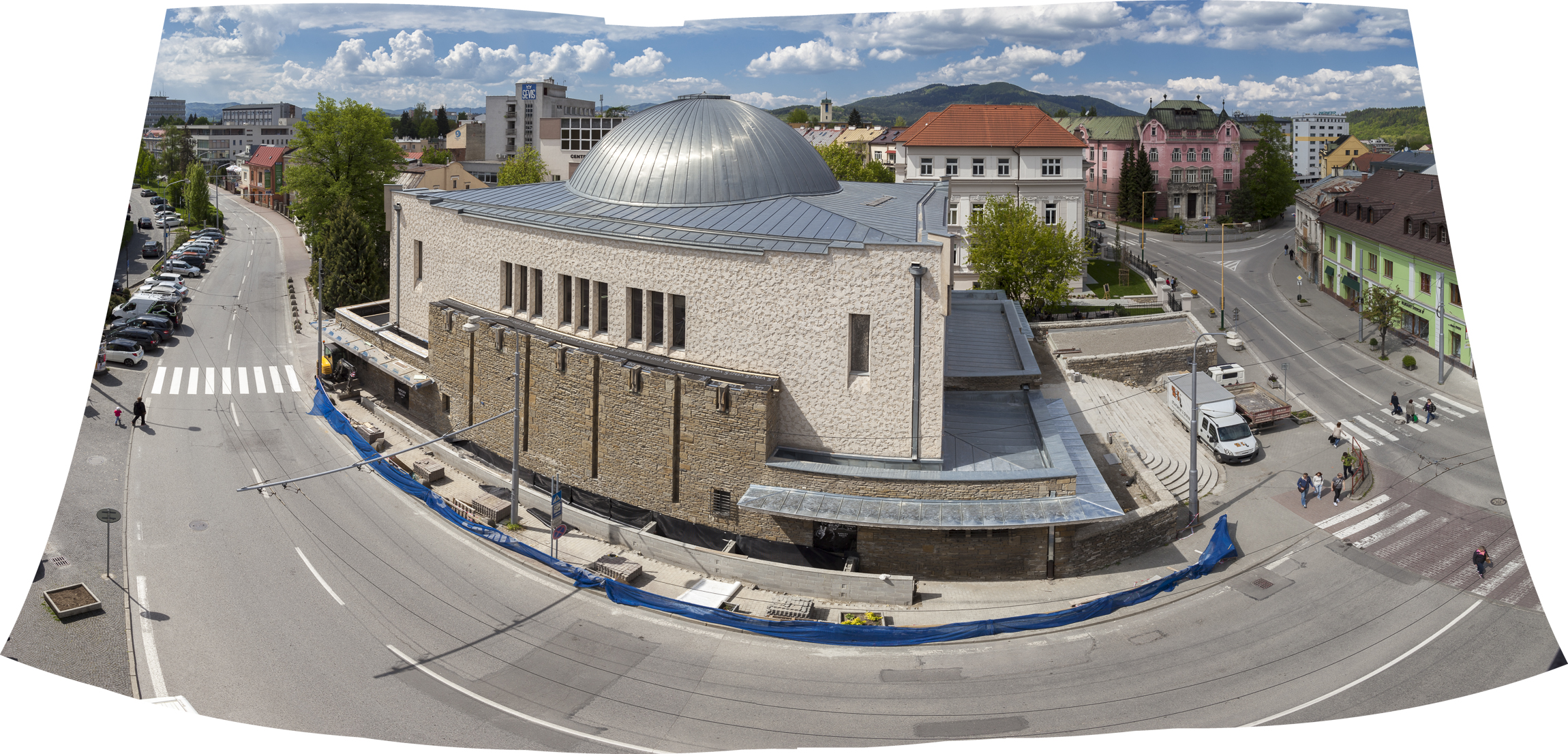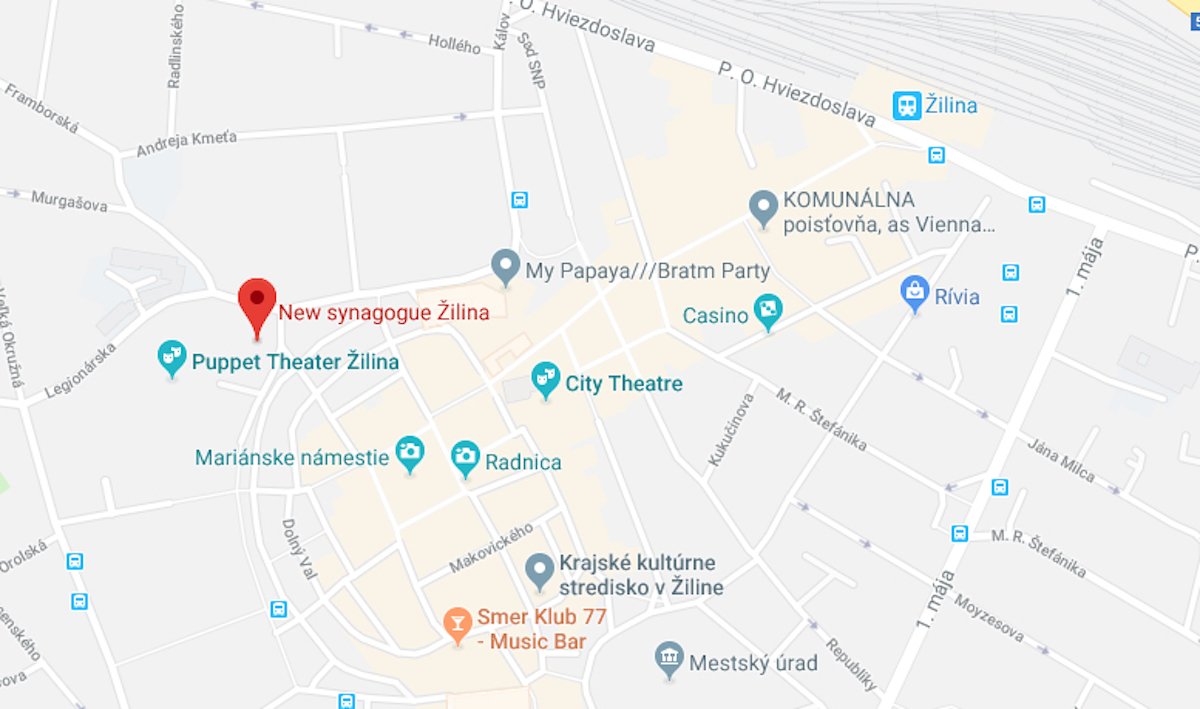
Nová synagóga Žilina
centre of contemporary arts and culture
J. M. Hurbana 220/11, 01001 Žilina
Opening hours:
Wednesday – Sunday 1pm – 7pm
(or upon request – please call +421907137145 or write info@novasynagoga.sk)
Current exhibition and events:
see at www.novasynagoga.sk/program (only in Slovak)
The New Synagogue in Žilina
Completed in 1931, the Synagogue of Neologs in the historical centre of Žilina is one of the most important buildings in Slovakia to have been built in the modern style. It is the only work in Slovakia designed by renowned and progressive German architect Peter Behrens. It served the local Jewish community for less than two decades before the tragic World Wall II., after which it housed concert and theatre hall, university and cinema. Since 1963 it has been a national cultural monument. The reconstruction and restoration started in 2011 and in 2017 the space re-opened. Our intention is not only restored Behrens’ landmark, but also new life in it. The aim is to create an exhibition space for contemporary art and other cultural activities with international dimension. Institution with quality curatorial programs and a clear profile that will combine the production of exhibitions and intellectual discourse with other local community activities.
When the spirit overcomes the substance, the world becomes a more interesting place. Art, philosophy and literature are useless and therefore to our needs fundamental.
At first sight from the distance (like from Bratislava or Košice), the reconstruction of an important cultural monument – New Synagogue in Žilina – might be seen as something unbelievable. Looking at it from a bigger distance, like from Amsterdam or Berlin, it does not make sense at all. The Dutch and the German don’t understand that somewhere in Slovakia a small nonprofit association is reconstructing such an important landmark of modern architecture by Peter Behrens. And even from further distance (from Oslo, Reykjavik and Vaduz) has arrived the main part of financial support in a form of an EEA Grant. And what is our project actually about? In the first place there was no project, because at the beginning we did know nothing. Nothing about the building nor about the financing, nothing even about the Kunsthalle – the institution which was planned to emerge. Practically the only motivation we had was that we will stand together. But a project can not be built only on that.
It was not a dream neither because from the beginning it has been a rational business. We did not know anything about the building and the financing, we believed in ourselves though and this happened to be enough. It was not necessary to use intuition or subconsciousness, we did not rely on the power of desire, on blue sky talks neither. We relied only on our individual and collective mind.
Although in some moments we had to stop working, because we were too impressed. Also few things happened which we could label as magical. We call the process a story because it has had signs of a fiction. At the beginning there was an introduction, later a conflict. And recently we are at the end of the culminating point. But the most fascinating part – the part which is usually the reason why people need stories – is still ahead of us: a peripety. And then the last one part of course – a catastrophe. That we will see. But now the question is why we speak about a story knowing that we are not literary characters. Because it is a literature: to live non stop with a question about how to live our lives. And even if this looks like a reality it is not because nothing is for sure. Everything must be questioned, you could be changed completely and also you could loose everything at anytime. But the most essential thing is this: let the ending be open, it is important to work knowing that everything is still under our control. Then we can say: we are independent, we are free. It is not about money, fame or career. There are different privileges. The world is much more interesting place when the spirit overcomes the substance.
Reconstruction and restoration
The project of restoration of the New Synagogue and its revitalization for Kunsthalle is implemented by the NGO Truc sphérique (cultural center Stanica Žilina-Záriečie) in cooperation with the generous owner of the monument – Jewish Community in Žilina. In early 2011, we learned that they are looking for a new tenant of the empty synagogue. After understanding the importance of the building’s protection from possible commercial use, we submitted our project to renovate the site for cultural purposes. We have gained confidence in this utopian plan backed by a 30-year contract with a token rent. We started the first studies and in 2012 the first restoration work. Since then we are doing what we can to meet demands, which puts the building itself and we feel that we are (together with all of you) part of one of the greatest adventures of our generation.
In 2017 the space re-opened after complete restoration of Behrens’ architecture and interior, the author for adaptation for new function was Martin Jančok from PLURAL studio. The seven-year reconstruction cost 1.5 million euros, one half of which was covered by private sources. A large part was crowdfunded in a public collection – there were more than 3,000 people who contributed. The second half of the funds came from public sources – particularly the EEA Grants, EU funds, the Slovak Ministry of Culture, and the city of Žilina. The work is worth 2-3 million euros because many things were done for free. The project received the Bauwelt Advancement Award 2013 in Germany, CE-ZA-AR Award for Architecture in 2018 and other prizes, especially for its grass root voluntary effort.
Thanks to the nonprofit intention and a good start, the project has gradualy created a team of more than 20 experts – cultural activists and curators, architectural historians and restorers, architects and designers and other people who (everyone for himself, and from his point of view) move the work forward. Despite the task is much bigger than it might seem at first glance. Besides, we have the support of dozens of large and small corporate supporters and grant subsidies and nearly two thousand private donors who have contributed to public collection. Every piece of mosaic is important.
Thank you all for your support!

